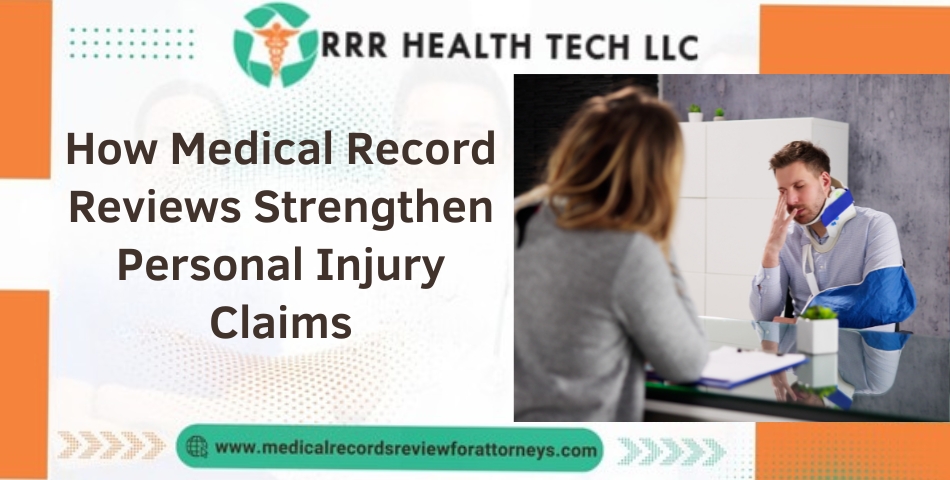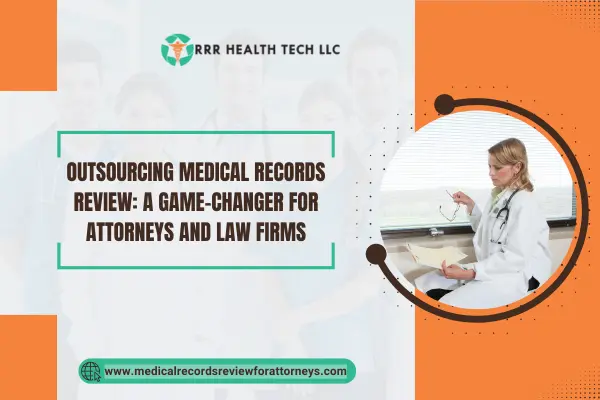Introduction

Have you ever wondered how personal injury claims get proven in court? Many people assume that just having an injury is enough, but that’s far from the truth. The success of a personal injury claim often depends on the strength of medical evidence. This is where medical record reviews come in. They provide concrete proof of an injury, validate treatment history, and establish the link between the accident and the harm suffered.
When done correctly, reviewing medical records can significantly impact the outcome of a case, ensuring victims get the compensation they deserve. But how exactly do they work? Let’s dive into the details.
Understanding Personal Injury Claims
A personal injury claims arises when someone is injured due to another person’s negligence. These claims cover various incidents, including:
- Car accidents
- Slip and falls
- Medical malpractice
- Workplace injuries
- Product liability cases
In each of these situations, the injured party (plaintiff) must prove liability and damages. Simply stating that you were hurt is not enough—strong medical documentation is needed to support the claim.
What Are Medical Record Reviews?
A medical record review is the thorough examination of medical documents related to an injury claim. This process involves:
- Gathering hospital records, doctor’s notes, lab reports, and imaging scans
- Identifying inconsistencies or missing information
- Analyzing whether the treatment aligns with the claimed injury
- Assessing the long-term impact of the injury
Personal injury lawyers and medical professionals conduct these reviews to ensure the medical evidence is accurate, complete, and legally sound.
The Role of Medical Records in Personal Injury Cases
Medical records are the backbone of any personal injury claim. They serve as objective evidence that supports an individual’s injuries and treatment history. Without these records, proving the severity of injuries or linking them to the incident becomes incredibly difficult.
Medical records help in the following ways:
- Proving Causation – A well-documented medical record connects the injury directly to the accident, showing there were no pre-existing conditions responsible for the harm.
- Demonstrating the Severity of Injuries – Detailed reports from doctors, diagnostic imaging results, and specialist evaluations illustrate how serious the injury is.
- Justifying Medical Treatment and Expenses – Every test, surgery, and therapy session included in the medical records strengthens the claim for medical reimbursement.
- Estimating Future Medical Needs – Some injuries require long-term care. Records help lawyers estimate future medical costs, which is crucial in settlements.
Without proper medical records, insurance companies can deny or reduce compensation claims by arguing that injuries are exaggerated or unrelated to the accident.
How Medical Record Reviews Support Injury Claims
A thorough medical record review ensures that all the necessary information is included and supports the claim. This process helps in multiple ways:




These reviews serve as powerful tools in personal injury cases, helping attorneys build a compelling case for maximum compensation.
Ensuring Accuracy in Injury Claims
Accuracy in medical records is crucial for a strong personal injury claim. Even small inconsistencies can give insurance companies and defense attorneys reasons to question the case. A thorough medical record review helps identify and correct potential issues before they become obstacles.
Some common inconsistencies that can weaken a claim include:
- Discrepancies in injury descriptions – If a patient describes an injury one way to a doctor and differently in legal documents, it can create doubt.
- Gaps in treatment – Delayed or inconsistent medical visits may lead insurers to argue that the injury wasn’t serious.
- Pre-existing conditions – Without proper documentation, insurance companies may blame current injuries on past medical issues.
- Incomplete records – Missing test results, progress notes, or specialist evaluations can weaken the claim.
By carefully reviewing all records, lawyers and medical experts can ensure that the medical history aligns with the injury claim, making it harder for insurance companies to deny compensation.
Common Types of Medical Records Used
A comprehensive review involves various medical documents that collectively provide a full picture of the injury and its impact. The most commonly reviewed records include:
- Hospital and Emergency Room Reports – Immediate medical care after an accident is critical for proving injuries.
- Doctor’s Notes and Progress Reports – Ongoing treatment records show the recovery process and any lingering effects.
- Radiology and Imaging Reports – X-rays, MRIs, and CT scans provide visual evidence of fractures, soft tissue damage, or internal injuries.
- Physical Therapy Records – Documentation of rehabilitation efforts helps justify pain and suffering damages.
- Prescription and Medication Records – Proof of prescribed pain management or long-term treatment supports the severity of the injury.
These records collectively strengthen a claim by painting a clear, medically supported picture of how the injury occurred and its long-term consequences.
How Lawyers Use Medical Record Reviews
Personal injury attorneys rely heavily on medical record reviews to build a compelling case for their clients. These records provide crucial evidence that helps attorneys:




By thoroughly analyzing every medical document, lawyers can prevent insurers from using pre-existing conditions, treatment gaps, or minor inconsistencies as excuses to deny a claim.
Challenges in Reviewing Medical Records
Despite their importance, medical record reviews come with several challenges that can complicate the legal process. Some of the most common hurdles include:




To overcome these challenges, attorneys work with medical experts, legal professionals, and record retrieval specialists to ensure they have accurate and complete documentation.
The Role of Medical Experts in Review
Medical experts play a vital role in personal injury claims, especially when reviewing complex medical records. Their expertise helps attorneys and insurance companies understand the severity and long-term impact of an injury.
Here’s how medical experts contribute to personal injury cases:




Without expert medical review, insurance companies may argue that injuries are not severe enough or not directly caused by the accident, reducing settlement amounts.
Electronic Health Records vs. Paper Records
In today’s medical and legal fields, records come in two formats: electronic health records (EHRs) and traditional paper records. Both have their advantages and challenges in personal injury cases.
| Type of Record | Pros | Cons |
|---|---|---|
| Electronic Health Records (EHRs) | Easy to retrieve, clear documentation, timestamps prevent tampering | May contain too much irrelevant data, risk of errors from automated entries |
| Paper Records | Often contain handwritten doctor notes with more detailed observations | Can be lost, illegible, or incomplete |
Attorneys often request both types of records to ensure a complete and accurate medical history.
HIPAA and Privacy Concerns in Record Reviews
Since medical records contain sensitive personal information, obtaining and reviewing them must comply with privacy laws, particularly HIPAA regulations.
To protect patient confidentiality:
- Only authorized individuals (lawyers, medical experts, and insurance adjusters) can access medical records.
- Patients must sign a medical release form before records can be reviewed.
- Law firms must ensure secure storage and transmission of medical records to prevent breaches.
Failure to follow these regulations can result in legal penalties and even the dismissal of an injury claim.
How to Obtain and Organize Medical Records for Claims
Obtaining and organizing medical records is a critical step in building a strong personal injury claim. Proper documentation ensures that nothing is overlooked and that all medical evidence aligns with the case.
Steps to Obtain Medical Records
- Request a Medical Authorization Form – The injured party must sign a HIPAA-compliant release form to allow attorneys or insurance adjusters to access records.
- Identify All Medical Providers – This includes hospitals, urgent care centers, physical therapists, specialists, and pharmacies involved in the treatment.
- Submit Formal Record Requests – Requests must be sent in writing to each provider, often with a fee for processing.
- Follow Up Regularly – Medical record requests can take weeks or months. Frequent follow-ups prevent delays in the case.
- Verify the Records for Completeness – Once received, records should be reviewed to ensure nothing is missing or incorrect.
Best Practices for Organizing Medical Records




Properly organized records speed up legal proceedings, making it easier to negotiate settlements or present evidence in court.
The Impact of Thorough Medical Record Reviews on Settlement Value
A well-documented medical record review can significantly increase settlement amounts in personal injury cases. Insurance companies rely on these records to determine how much they are willing to pay.
Here’s how a strong review impacts compensation:




When all medical evidence is accurate and well-documented, it often leads to faster settlements and higher compensation.
Case Studies: Successful Injury Claims with Strong Medical Reviews
Examining real-life cases demonstrates how thorough medical record reviews can make or break a personal injury claim. Here are a few examples where proper documentation played a crucial role in securing compensation:
Case 1: Car Accident with Delayed Symptoms
- A woman involved in a rear-end collision initially reported mild neck pain but sought medical attention two weeks later when symptoms worsened.
- A detailed medical record review connected her spinal injuries to the accident, countering the insurance company’s argument that the delay indicated a pre-existing condition.
- Outcome: A $250,000 settlement after proving the delayed symptoms were a direct result of the crash.
Case 2: Workplace Injury and Pre-existing Condition
- A construction worker suffered a severe back injury but had a history of prior back issues.
- A thorough review of medical records differentiated the new injury from the pre-existing condition, reinforcing the claim that the accident aggravated his condition.
- Outcome: The employer’s insurance initially denied the claim, but with expert medical testimony, the worker received a $500,000 compensation package for lost wages and medical expenses.
Case 3: Slip and Fall with Inconsistent Records
- A grocery store customer slipped on a wet floor with no warning signs, suffering a broken hip.
- The store’s lawyers argued that the injury could have been from a previous fall.
- A detailed medical review proved the fracture was fresh and directly linked to the incident.
- Outcome: The victim was awarded $300,000 for medical expenses and pain and suffering.
These cases highlight how accurate and well-reviewed medical records can make a major difference in personal injury settlements.
Red Flags That Can Weaken Injury Claims
While strong medical records can boost a case, certain red flags can lead to denied or reduced claims:





Avoiding these pitfalls through thorough medical record reviews ensures that a personal injury claim remains strong and credible.
The Importance of Timely Medical Record Reviews
Time is a crucial factor in personal injury claims, and delays in reviewing medical records can negatively impact a case. Conducting timely medical record reviews ensures that:




Waiting too long to review records can lead to challenges such as lost medical documentation, expired deadlines for filing claims, and difficulties proving the direct connection between the injury and the accident.
Conclusion
Medical record reviews are a critical component of personal injury claims, ensuring that injuries, treatments, and long-term impacts are properly documented and legally sound. These reviews help:
- Strengthen causation and damages claims
- Justify medical expenses and future costs
- Prevent disputes with insurance companies
- Maximize settlement value
By working with legal professionals and medical experts, injury victims can build stronger cases, avoid common pitfalls, and secure the compensation they deserve.
If you’re involved in a personal injury case, don’t underestimate the power of medical records—they could be the key to winning your claim!


